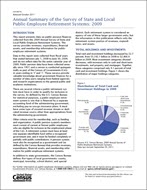Annual Summary of the Survey of State and Local Public-Employee Retirement Systems: 2009
Annual Summary of the Survey of State and Local Public-Employee Retirement Systems: 2009
Introduction
This report presents data on public pension finances collected from the 2009 Annual Survey of State and Local Public-Employee Retirement Systems. The survey provides revenues, expenditures, financial assets, and membership information for public-employee retirement systems.
Data in this report were collected from fiscal years that ended between July 1, 2008 to June 30, 2009, and do not reflect data for the entire calendar year of 2009. Public pension data have been collected annually since 1957, and a census is conducted quinquennially as part of the Census of Governments (CoG) in years ending in ‘2’ and ‘7.’ These surveys provide valuable knowledge about government finances for a number of data users ranging from federal agencies and research organizations to the general public and academic institutions.
There are several criteria a public retirement system must have in order to qualify for inclusion in the survey. As defined by the U.S. Census Bureau for statistical purposes, a public-employee retirement system is one that is financed by a separate accounting fund of the administering government, excluding pay-as-you-go insurance plans. It must have some type of assured revenue stream or dedicated revenue source other than appropriations from the administering government.
Other criteria exist for membership, such as funding and organization. A public pension system’s members must consist of current or former public employees who are eligible for inclusion in the employment phase of the CoG. A retirement system must have at least one separate identifiable fund within a recognized government unit, and it must be funded completely or partially with public contributions. A pension system must also be recognized as a government unit (as defined by the Census Bureau) that provides revenues, expenditures, financial assets, and membership information for public-employee retirement systems.
In addition to state governments, the Census Bureau defines five types of local governments: county, municipal, township, school district, and special district. Each retirement system is considered an agency of one of these larger government units, but the information in this publication reflects only the retirement system portion of revenues, expenditures, and assets.
The Annual Survey of State & Local Public-Employee Retirement Systems provides revenues, expenditures, financial assets, and membership information for public employee retirement systems. Data are shown for individual retirement systems as well as at the national, state, and local level. There were 3,418 public employee retirement systems in the sampling frame, of which 1,798 systems were selected for the sample. The increase in the number of systems from 2008 to 2009 is due to an increase in coverage of the retirement systems in Florida, Illinois, Minnesota, Pennsylvania, and Texas. A sample of these units was added in 2009. The coverage was improved through research and greatly impacted the local retirement systems universe. Any year-to-year comparisons should be exercised with caution.
The 2009 survey covered fiscal years that ended between July 1, 2008 and June 30, 2009 and does not reflect data for the entire calendar year of 2009.
Downloadable Data
Table 2. Revenues by State & Local Government
Table 3. Expenditures by State & Local Government
Table 4. Cash and Investments by State & Local Government
Table 5. Membership by State & Local Government
Aggregates for the U.S. and by state of local government retirement systems and state retirement systems.
Downloadable Dataset
Detailed financial item data for each state-administered public pension system (fixed length, no delimiter).
File Layout
Unit ID File
Name of each state-administered public pension system (fixed length, no delimiter).









